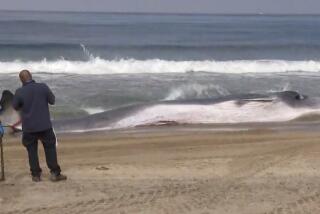An ‘Alien’-like marine creature washed ashore near Laguna Niguel over the weekend

- Share via
- The otherworldly looking sea creature that washed up near Laguna Niguel was actually a fairly common fish, the moray eel.
- The eel’s teeth point backward, making it hard for anything it has bitten to break free.
What has many rows of teeth, a terrifying set of jaws and a corpse-like pallor?
If you guessed the titular villain in Ridley Scott’s 1979 horror film, you’d be correct. But a version of the creature that inspired Scott’s “Alien” also washed ashore over the weekend near Laguna Niguel.
“It’s giving me nightmares,” wrote a Reddit user on Saturday, posting a picture of what appeared to be a dead moray eel on the beach. The creature’s jaws were open, exposing its many teeth.
Moray eels are common in Southern California, and they’ve washed ashore multiple times in the past, according to California Department of Fish and Wildlife spokesperson Tim Daly.
“It looks like it might be a little bleached from being dead,” Daly said of the latest visitor from Planet Moray. The usual hue of the living version is greenish-brown, according to John Ugoretz, pelagic fisheries and ecosystem program manager for the department.
A group of kayakers and snorkelers came across a rare deep-sea oarfish floating in the waters off San Diego.
California moray eels live in coral reefs from Point Conception in Santa Barbara County to southern Baja California in Mexico, according to the Monterey Bay Aquarium. They feed on small reef fishes, shrimps, octopuses, crabs, sea urchins and lobsters.
They grow to around 5 feet long, according to the aquarium. Instead of having gill covers like most other fish, moray eels breathe by opening and closing their mouths, appearing as if they’re gasping for breath.
“I think this one drew people’s people’s attention because of the way the teeth and head look on the moray eel and the fact that it was bleached out,” Ugoretz said of the online post.
The moray eel has a double row of pointed teeth that angle backward, so once it bites something, its prey has a really hard time escaping, he added.
The moray’s sharp teeth are coated in bacteria, so their bites can be not only painful but cause infection, according to the Monterey Bay Aquarium. The creature doesn’t tend to bite, however, unless scared or disturbed.
More to Read
Sign up for Essential California
The most important California stories and recommendations in your inbox every morning.
You may occasionally receive promotional content from the Los Angeles Times.












